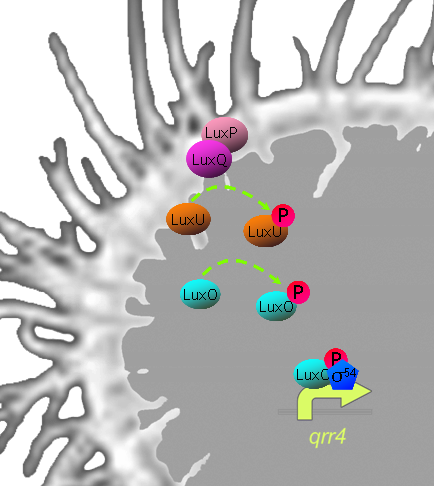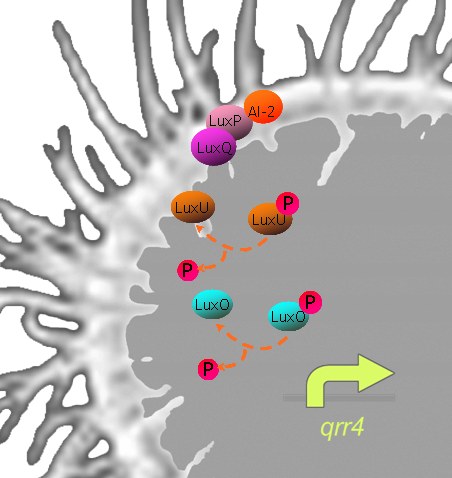Team:Calgary/Lab/Signalling
From 2009.igem.org
(Difference between revisions)
| (5 intermediate revisions not shown) | |||
| Line 71: | Line 71: | ||
<div class="heading">SIGNALLING CIRCUIT</div> | <div class="heading">SIGNALLING CIRCUIT</div> | ||
<div class="desc"> | <div class="desc"> | ||
| - | <img src="http://i1001.photobucket.com/albums/af132/igemcalgary/l.gif" align="left" hspace=10> | + | <img src="http://i1001.photobucket.com/albums/af132/igemcalgary/l.gif" align="left" hspace=10> |
| + | The signalling circuit houses the genes that are required to produce the proteins present in the AI-2 signalling cascade. It contains the LuxPQ and LuxOU operons, each under the control of different promoters. LuxOU is constitutively expressed under the TetR promoter (BBa_R0040), where LuxPQ is under control of the synthetic sigma 70 promoter designed to produce ideal amounts of these periplasmic proteins to optimize AI-2 signalling. | ||
</div> | </div> | ||
<br> | <br> | ||
| Line 81: | Line 82: | ||
<html> | <html> | ||
<br> | <br> | ||
| - | <b>Figure 1. AI-2 signalling cascade in the absence (left) and presence (right) of AI-2.</b> In the absence of AI-2, LuxQ autophosphorylates and subsequently phosphorylates the cytoplasmic protein LuxU, which passes its phosphate to LuxO. Phospho-LuxO complexes with transcription factor σ54 to activate the transcription of genes downstream of one of the five qrr4 promoters. The promoter depicted here is qrr4, as it is the one engineered into our system. (b) In the presence of AI-2, LuxQ changes from a kinase to a | + | <b>Figure 1. AI-2 signalling cascade in the absence (left) and presence (right) of AI-2.</b> <br><br>In the absence of AI-2, LuxQ autophosphorylates and subsequently phosphorylates the cytoplasmic protein LuxU, which passes its phosphate to LuxO. Phospho-LuxO complexes with transcription factor σ54 to activate the transcription of genes downstream of one of the five qrr4 promoters. The promoter depicted here is qrr4, as it is the one engineered into our system. (b) In the presence of AI-2, LuxQ changes from a kinase to a phosphatase, and thus removes the phosphate of LuxU, which subsequently removes the phosphate of LuxO. Nothing binds to the qrr4 promoter and therefore there is no expression of downstream genes. |
</html> | </html> | ||
[[Image:signalling.png|700px]] | [[Image:signalling.png|700px]] | ||
<html> | <html> | ||
<br> | <br> | ||
| - | <b>Figure 2. Schematic depiction of AI-2 signalling circuit.</b> This genetic circuit encodes the proteins necessary for the AI-2 signalling cascade (see Figure 1). Curved arrows represent promoters, while straight arrows represent genes. The luxOU operon is under constitutive control of the TetR promoter (BBa_R0040), whereas the ∆luxPQ operon is under control of the ∆σ70 promoter, allowing for control of expression levels. For simplicity, the terminators after each operon are not shown in this circuit. | + | <b>Figure 2. Schematic depiction of AI-2 signalling circuit.</b> <br><br> |
| + | This genetic circuit encodes the proteins necessary for the AI-2 signalling cascade (see Figure 1). Curved arrows represent promoters, while straight arrows represent genes. The luxOU operon is under constitutive control of the TetR promoter (BBa_R0040), whereas the ∆luxPQ operon is under control of the ∆σ70 promoter, allowing for control of expression levels. For simplicity, the terminators after each operon are not shown in this circuit. | ||
<br> | <br> | ||
<br> | <br> | ||
| - | For an in depth look at the construction of the signalling circuit complete with results, please see the papers below. These papers both deal with signalling circuit construction, although from different perspectives: LuxPQ and LuxOU. | + | <br> |
| + | For an in depth look at the construction of the signalling circuit complete with results, please see the papers below or at the following links: <a href="https://static.igem.org/mediawiki/2009/3/3f/Calgary_Signalling_Circuit_luxPQ.pdf">LuxPQ</a> & <a href="https://static.igem.org/mediawiki/2009/9/99/Calgary_Signalling_Circuit_luxOU.pdf">LuxOU</a>. These papers both deal with signalling circuit construction, although from different perspectives: LuxPQ and LuxOU. | ||
| + | <br> | ||
| + | <center> | ||
| + | <a title="View Signalling Circuit LuxPQ on Scribd" href="http://www.scribd.com/doc/21377450/Signalling-Circuit-LuxPQ" style="margin: 12px auto 6px auto; font-family: Helvetica,Arial,Sans-serif; font-style: normal; font-variant: normal; font-weight: normal; font-size: 14px; line-height: normal; font-size-adjust: none; font-stretch: normal; -x-system-font: none; display: block; text-decoration: underline;">Signalling Circuit LuxPQ</a> <object codebase="http://download.macromedia.com/pub/shockwave/cabs/flash/swflash.cab#version=9,0,0,0" id="doc_395487447558567" name="doc_395487447558567" classid="clsid:d27cdb6e-ae6d-11cf-96b8-444553540000" align="middle" height="700" width="630" > <param name="movie" value="http://d1.scribdassets.com/ScribdViewer.swf?document_id=21377450&access_key=key-5ec0b3tsdrge6a6zj9b&page=1&version=1&viewMode=list"> <param name="quality" value="high"> <param name="play" value="true"> <param name="loop" value="true"> <param name="scale" value="showall"> <param name="wmode" value="opaque"> <param name="devicefont" value="false"> <param name="bgcolor" value="#ffffff"> <param name="menu" value="true"> <param name="allowFullScreen" value="true"> <param name="allowScriptAccess" value="always"> <param name="salign" value=""> <param name="mode" value="list"> <embed src="http://d1.scribdassets.com/ScribdViewer.swf?document_id=21377450&access_key=key-5ec0b3tsdrge6a6zj9b&page=1&version=1&viewMode=list" quality="high" pluginspage="http://www.macromedia.com/go/getflashplayer" play="true" loop="true" scale="showall" wmode="opaque" devicefont="false" bgcolor="#ffffff" name="doc_395487447558567_object" menu="true" allowfullscreen="true" allowscriptaccess="always" salign="" type="application/x-shockwave-flash" align="middle" mode="list" height="700" width="630"></embed> </object> | ||
| + | <br><br> | ||
| + | |||
| + | <a title="View Signalling Circuit LuxOU on Scribd" href="http://www.scribd.com/doc/21377668/Signalling-Circuit-LuxOU" style="margin: 12px auto 6px auto; font-family: Helvetica,Arial,Sans-serif; font-style: normal; font-variant: normal; font-weight: normal; font-size: 14px; line-height: normal; font-size-adjust: none; font-stretch: normal; -x-system-font: none; display: block; text-decoration: underline;">Signalling Circuit LuxOU</a> <object codebase="http://download.macromedia.com/pub/shockwave/cabs/flash/swflash.cab#version=9,0,0,0" id="doc_193213473306799" name="doc_193213473306799" classid="clsid:d27cdb6e-ae6d-11cf-96b8-444553540000" align="middle" height="700" width="630" > <param name="movie" value="http://d1.scribdassets.com/ScribdViewer.swf?document_id=21377668&access_key=key-1zqhecth5yk81372cc36&page=1&version=1&viewMode=list"> <param name="quality" value="high"> <param name="play" value="true"> <param name="loop" value="true"> <param name="scale" value="showall"> <param name="wmode" value="opaque"> <param name="devicefont" value="false"> <param name="bgcolor" value="#ffffff"> <param name="menu" value="true"> <param name="allowFullScreen" value="true"> <param name="allowScriptAccess" value="always"> <param name="salign" value=""> <param name="mode" value="list"> <embed src="http://d1.scribdassets.com/ScribdViewer.swf?document_id=21377668&access_key=key-1zqhecth5yk81372cc36&page=1&version=1&viewMode=list" quality="high" pluginspage="http://www.macromedia.com/go/getflashplayer" play="true" loop="true" scale="showall" wmode="opaque" devicefont="false" bgcolor="#ffffff" name="doc_193213473306799_object" menu="true" allowfullscreen="true" allowscriptaccess="always" salign="" type="application/x-shockwave-flash" align="middle" mode="list" height="700" width="630"></embed> </object> | ||
| + | </center> | ||
| + | </div> | ||
| + | <br> | ||
</td> | </td> | ||
</tr> | </tr> | ||
Latest revision as of 07:02, 21 October 2009
UNIVERSITY OF CALGARY

 "
"











 The signalling circuit houses the genes that are required to produce the proteins present in the AI-2 signalling cascade. It contains the LuxPQ and LuxOU operons, each under the control of different promoters. LuxOU is constitutively expressed under the TetR promoter (BBa_R0040), where LuxPQ is under control of the synthetic sigma 70 promoter designed to produce ideal amounts of these periplasmic proteins to optimize AI-2 signalling.
The signalling circuit houses the genes that are required to produce the proteins present in the AI-2 signalling cascade. It contains the LuxPQ and LuxOU operons, each under the control of different promoters. LuxOU is constitutively expressed under the TetR promoter (BBa_R0040), where LuxPQ is under control of the synthetic sigma 70 promoter designed to produce ideal amounts of these periplasmic proteins to optimize AI-2 signalling.


